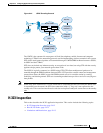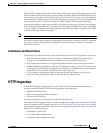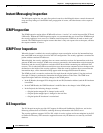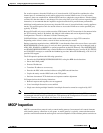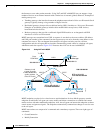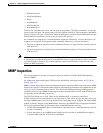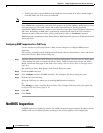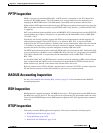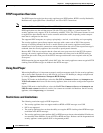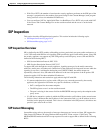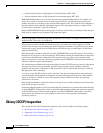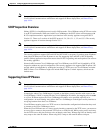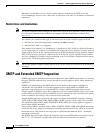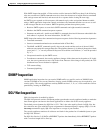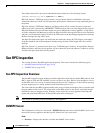
24-19
Cisco ASDM User Guide
OL-16647-01
Chapter 24 Configuring Application Layer Protocol Inspection
PPTP Inspection
PPTP Inspection
PPTP is a protocol for tunneling PPP traffic. A PPTP session is composed of one TCP channel and
usually two PPTP GRE tunnels. The TCP channel is the control channel used for negotiating and
managing the PPTP GRE tunnels. The GRE tunnels carries PPP sessions between the two hosts.
When enabled, PPTP application inspection inspects PPTP protocol packets and dynamically creates the
GRE connections and xlates necessary to permit PPTP traffic. Only Version 1, as defined in RFC 2637,
is supported.
PAT is only performed for the modified version of GRE [RFC 2637] when negotiated over the PPTP TCP
control channel. Port Address Translation is not performed for the unmodified version of GRE [RFC
1701, RFC 1702].
Specifically, the security appliance inspects the PPTP version announcements and the outgoing call
request/response sequence. Only PPTP Version 1, as defined in RFC 2637, is inspected. Further
inspection on the TCP control channel is disabled if the version announced by either side is not Version
1. In addition, the outgoing-call request and reply sequence are tracked. Connections and xlates are
dynamic allocated as necessary to permit subsequent secondary GRE data traffic.
The PPTP inspection engine must be enabled for PPTP traffic to be translated by PAT. Additionally, PAT
is only performed for a modified version of GRE (RFC2637) and only if it is negotiated over the PPTP
TCP control channel. PAT is not performed for the unmodified version of GRE (RFC 1701 and
RFC 1702).
As described in RFC 2637, the PPTP protocol is mainly used for the tunneling of PPP sessions initiated
from a modem bank PAC (PPTP Access Concentrator) to the headend PNS (PPTP Network Server).
When used this way, the PAC is the remote client and the PNS is the server.
However, when used for VPN by Windows, the interaction is inverted. The PNS is a remote single-user
PC that initiates connection to the head-end PAC to gain access to a central network.
RADIUS Accounting Inspection
See the “Select RADIUS Accounting Map” section on page 22-14 for information about RADIUS
accounting inspection.
RSH Inspection
RSH inspection is enabled by default. The RSH protocol uses a TCP connection from the RSH client to
the RSH server on TCP port 514. The client and server negotiate the TCP port number where the client
listens for the STDERR output stream. RSH inspection supports NAT of the negotiated port number if
necessary.
RTSP Inspection
This section describes RTSP application inspection. This section includes the following topics:
• RTSP Inspection Overview, page 24-20
• Using RealPlayer, page 24-20
• Restrictions and Limitations, page 24-20



